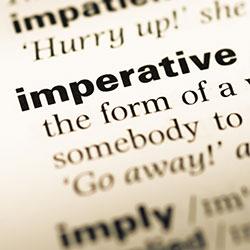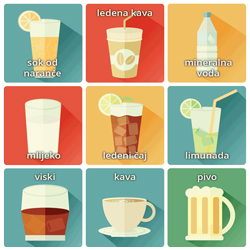In this blog post you will learn about what the imperative is used for, how to construct the negative form, how to use irregular verbs (because there are always slight complications ????) and how to make all of the forms of imperative sound more pleasant.
Probably the best examples of imperative sentences are the ones a parent uses when “talking to” their kids:
How is the imperative formed?
To form the imperative, you need to know the third person plural of the present tense of a verb and then build from there by adding various endings.
This is the imperative formed with the most frequent types of verbs:
| category | infinitive | present
(3rd person plural) | imperative
(2nd person singular) | imperative
(1st person plural) | imperative
(2nd person plural) |
|---|
| -ati |
pjevati
(to sing) |
-aju
pjevaju |
Pjevaj! |
Pjevajmo! |
Pjevajte! |
| -ivati |
istraživati
(to explore) |
-uju
istražuju |
Istražuj! |
Istražujmo! |
Istražujte! |
| -ovati |
putovati
(to travel) |
-uju
putuju |
Putuj! |
Putujmo! |
Putujte! |
| -iti |
raditi
(to work) |
-e
rade |
Radi! |
Radimo! |
Radite! |
| -jeti |
voljeti
(to love) |
-e
vole |
Voli! |
Volimo! |
Volite! |
There’s no imperative form for first person singular, because we don't usually give instructions to ourselves. And when we do, we talk to ourselves in the 2nd person singular.
Irregular verbs and the imperative form
Of course, like in every language, irregular verbs are, well, irregular! Here are a couple of examples of common irregular verbs:
| infinitive | present
(3rd person plural) | imperative
(2nd person singular) | imperative
(1st person plural) | imperative
(2nd person plural) |
|---|
biti
(to be) |
budu |
Budi! |
Budimo! |
Budite! |
ići
(to go) |
idu |
Idi! |
Idimo! |
Idite! |
jesti
(to eat) |
jedu |
Jedi! |
Jedimo! |
Jedite! |
piti
(to drink) |
piju |
Pij! |
Pijmo! |
Pijte! |
Imperative of the third person singular and plural
There’s no special form of imperative for the third person singular or plural (you or you all). Instead, the word neka (→ let) is used together with the present tense form of a verb.
Making negative imperative statements
The negative form of the imperative is formed by putting ne (→ no) in front of the imperative form or in front of the present form:
| infinitive | present
(3rd person plural) | imperative
(2nd person singular) | imperative
(1st person plural) | imperative
(2nd person plural) |
|---|
pjevati
(to sing) |
-aju
pjevaju |
Ne pjevaj!
(Don’t sing!) |
Ne pjevajmo! |
Ne pjevajte! |
istraživati
(to explore) |
-uju
istražuju |
Ne istražuj! |
Ne istražujmo! |
Ne istražujte! |
putovati
(to travel) |
-uju
putuju |
Ne putuj! |
Ne putujmo! |
Ne putujte! |
raditi
(to work) |
-e
rade |
Ne radi! |
Ne radimo! |
Ne radite! |
voljeti
(to love) |
-e
vole |
Ne voli! |
Ne volimo! |
Ne volite! |
Another way to make a negative imperative is by using the words nemoj (→ don’t, second person singular), nemojmo (→ first person plural), nemojte (→ second person plural) with the infinitive of a verb. This is an easier way to use the negative imperative, as you don't have to think about changing verb endings.
Third person singular and third person plural forms still use neka.
How to make the imperative sound more polite?
The imperative can sometimes be seen as overly direct, rude or impolite – maybe even offensive. In such cases, we can add molim (→ please) to soften the command.
For example: Kupi mi čokoladu, molim te. (Buy me a chocolate, please).
We can also use conditionals to make it less direct: Bi li mi kupio čokoladu? (→ Would you buy me a chocolate?). Or use the question form instead: Možeš li mi kupiti čokoladu (→ Can you buy me a chocolate?)
Exercise: How would you say the following in Croatian?
Bring me a beer. →
Answer
Donesi mi pivo!
Close the window. →
Answer
Zatvori prozor!
Finish your lunch. →
Answer
Pojedi ručak do kraja!
Let us sing until dawn. →
Answer
Pjevajmo do zore!
Buy me a watermelon. →
Answer
Kupi mi lubenicu!
Let her wash the dishes. →
Answer
Neka ona opere posuđe!
Exercise: See how much of this beautiful song by Natali Dizdar you understand!







